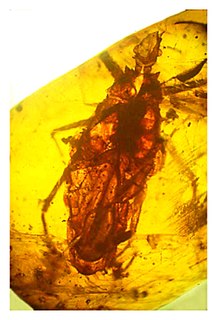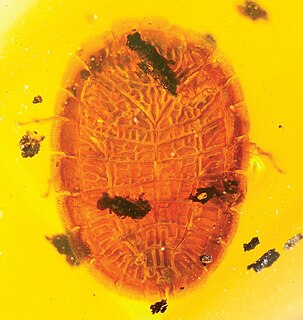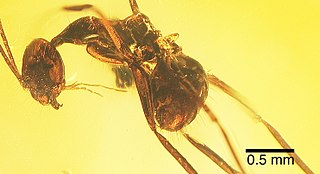
Triatoma dominicana is an extinct species of assassin bug in the subfamily Triatominae, the kissing bugs known from early Miocene Burdigalian stage Dominican amber deposits on the island of Hispaniola.

Termitaphididae, occasionally called termite bugs, is a small tropicopolitan family of true bugs placed in the superfamily Aradoidea. Typically members of Termitaphididae are small, being an average of 2 millimetres (0.079 in)-4 millimetres (0.16 in), and flattened with laminae extending out from each body segment giving a round scale like appearance. Currently the family contains two genera and twelve known species. Members of Termitaphididae are inquilines lodging in the nests of host species of termite families Termitidae and Rhinotermitidae. Though considered a separate family in Aradoidea it has been suggested by Drs David Grimaldi and Michael Engel in 2008 that Termataphididae may in fact be highly derived members of Aradidae. Of the thirteen known species one Termitaphis circumvallata belongs to the monotypic genus Termitaphis and four of the remaining eleven species in Termitaradus are extinct, having only been found in amber. The living species are found worldwide in the tropical regions of Central and South America, Africa, Asia, and Australia.

Termitaradus is a small tropicopolitan genus of true bugs placed in the family Termitaphididae. As is typical for the family, living members of Termitaradus are small, being an average of 2 millimetres (0.079 in) to 4 millimetres (0.16 in), and flattened with laminae extending out from each body segment giving a round scale like appearance. The same is true for the extinct species with the exception of T. protera which reaches 7 millimetres (0.28 in) in length. All members of Termitaphididae are inquilines lodging in the nests of host species of termites, with Termitaradus species known only from the family Rhinotermitidae. Though considered a separate family in Aradoidea it has been suggested by Drs David Grimaldi and Michael Engel in 2008 that Termataphididae may in fact be highly derived members of Aradidae. The second genus placed in Termitaphididae, Termitaphis, contains the monotypic species Termitaphis circumvallata which inhabits nests of Termitidae (termites) in Colombia.

Termitaradus mitnicki is an extinct species of true bug in the family Termitaphididae known only from early Miocene Burdigalian stage Dominican amber deposits on the island of Hispaniola.
Termitaradus protera is an extinct species of termite bug in the family Termitaphididae known from several Late Oligocene to Early Miocene fossils found in Mexico. T. protera is the only species in the extant genus Termitaradus to have been described from fossils found in Mexican amber and is one of four species from new world amber; the others are Termitaradus avitinquilinus, Termitaradus dominicanus and Termitaradus mitnicki. T. protera was also the first termite bug described from the fossil record.
Termitaradus avitinquilinus is an extinct species of termite bug in the family Termitaphididae known from several possibly Miocene fossils found in the Dominican Republic. T. avitinquilinus is the first species in the genus Termitaradus to have been described from fossils found in Dominican amber and is one of four species from New World amber, the others being Termitaradus protera, Termitaradus dominicanus and Termitaradus mitnicki.
Syndesus ambericus is an extinct species of stag beetles in the subfamily Syndesinae known from a single possibly Miocene fossil found on Hispaniola. S. ambericus is the first species of stag beetle to have been described from fossils found in Dominican amber and is one of four species from amber, and the only stag beetle species known from the Caribbean.
Anthophorula (Anthophorula) persephone is an extinct species of bee in the subfamily Apinae known from a pair of possibly Miocene fossils found on Hispaniola. A. persephone is the first species of the bee tribe Exomalopsini to have been described from fossils found in Dominican amber and is the only species of Anthophorula found in the West Indies.

Acanthostichus hispaniolicus is an extinct species of ant in the subfamily Dorylinae known from a group of possibly Miocene fossils found on the Caribbean island of Hispaniola. A. hispaniolicus is the first species of the ant genus Acanthostichus to have been described from fossils found in Dominican amber, and is the only species of Acanthostichus found in the West Indies.

Acropyga glaesaria is an extinct species of ant in the subfamily Formicinae known from a group of possibly Miocene fossils found on Hispaniola. A. glaesaria is the first species of the ant genus Acropyga to have been described from fossils found in Dominican amber and is the one of several species of Acropyga found in the West Indies. As with other members of the genus, A. glaesaria was most likely trophobiotic.
Acanthognathus poinari is an extinct species of ant in the subfamily Myrmicinae known from a single possibly Miocene fossil found on Hispaniola. A. poinari is the first species of the ant genus Acanthognathus to have been described from fossils found in Dominican amber and is one of several species of Acanthognathus found in the Greater Antillies.

Anochetus conisquamis is an extinct species of ant in the subfamily Ponerinae known from one possibly Miocene fossil found on Hispaniola. A. conisquamis is one of eight species in the ant genus Anochetus to have been described from fossils found in Dominican amber and is one of a number of Anochetus species found in the Greater Antilles.

Anochetus corayi is an extinct species of ant in the subfamily Ponerinae known from one possibly Miocene fossil found on Hispaniola. A. corayi is one of eight species in the ant genus Anochetus to have been described from fossils found in Dominican amber and is one of a number of Anochetus species found in the Greater Antillies.

Anochetus intermedius is an extinct species of ant in the subfamily Ponerinae known from two possibly Miocene fossils found on Hispaniola. A. intermedius is one of eight species in the ant genus Anochetus to have been described from fossils found in Dominican amber and is one of a number of Anochetus species found in the Greater Antilles.
Pseudarmadillo cristatus is an extinct species of isopod (woodlouse) in the family Delatorreiidae known from a series of possibly Miocene fossils found on Hispaniola. At the time of description P. cristatus was one of two Pseudarmadillo species known from the fossil record and one of only two from Hispaniola.
Pseudarmadillo tuberculatus is an extinct species of isopod in the family Delatorreiidae known from a series of possibly Miocene fossils found on Hispaniola. At the time of description P. tuberculatus was one of two Pseudarmadillo species known from the fossil record and one of only two from Hispaniola.
Apterostigma electropilosum is an extinct species of ant in the subfamily Myrmicinae known from a single possibly Miocene fossil found on Hispaniola. A. electropilosum is one of only two species of the ant genus Apterostigma and one of five attini species to have been described from fossils found in Dominican amber.
Apterostigma eowilsoni is an extinct species of ant in the subfamily Myrmicinae known from a single possibly Miocene fossil found on Hispaniola. A. eowilsoni is one of only two species of the ant genus Apterostigma and one of five attini species of to have been described from fossils found in Dominican amber.

Zatania electra is an extinct species of ant in the subfamily Formicinae known from three possibly Miocene fossils found on Hispaniola. Z. electra is one of several Zatania species found in the Greater Antilles.
Feroseta is an extinct genus of mantidfly in the neuropteran family Mantispidae known from a fossil found in North America, and which contains a single species, Feroseta prisca.







